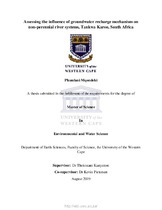| dc.description.abstract | In South Africa and neighbouring countries such as Zimbabwe, Botswana, Angola, and Namibia, most river systems are non-perennial due to semi-arid or arid climatic characteristics. In such river systems, the interaction between groundwater and surface water is of significance in terms of developing appropriate methods for determining ecological water requirements among others. However, the interaction is not well understood in terms of the influence on the volume and quality of water on the gaining and losing water bodies. In past research, the importance of non-perennial rivers (NPRS) was neglected because these river systems were considered as systems of low ecological importance and economic value. However, an improved understanding of these systems illustrated that they provide habitat for diverse and unique flora and fauna. Therefore, the main research question that was posed for the study was what is the influence of river-aquifer interactions in non-perennial river systems in the semi-arid environment?
The central argument was that unless we assess the interaction between surface water and groundwater in NPRS, we cannot improve on understanding of the role of groundwater on the NPRS. The aim of the study was therefore, to assess surface water-groundwater (river-aquifer) interactions in non-perennial river systems to provide an insight regarding how these water resources interact in semi-arid environments. To achieve the aim, three specific objectives were formulated, namely, to establish the groundwater contribution to the river system, to investigate the role of the river in recharging the underlying aquifer, and to develop a regional hydrogeological conceptual model of recharge mechanisms. To achieve the objectives of the study, samples were collected from boreholes, a dug well, springs, surface water and cumulative rainfall collectors during the summer and winter seasons. The samples were analysed for hydrochemistry and stable isotopic signatures (δ2H and δ18O). The intention was to identify where and when do river-aquifer interactions occur in the study area. Secondary data from records review and field data from hydrometric methods, ERT geophysical surveys and tracer techniques were also used to address the third objective. | en_US |

